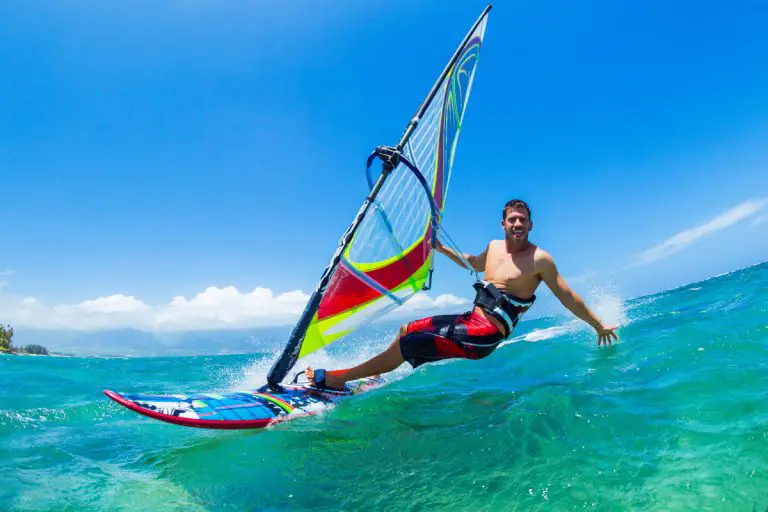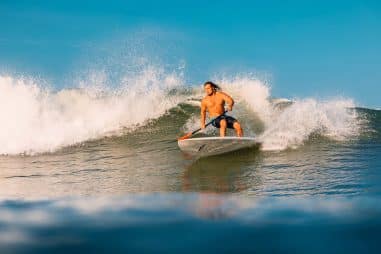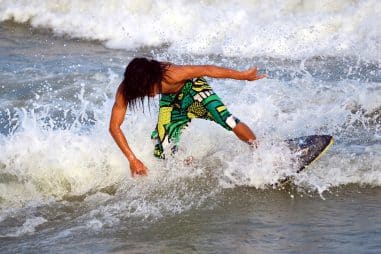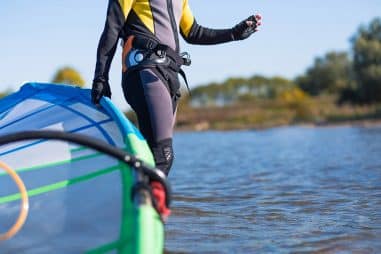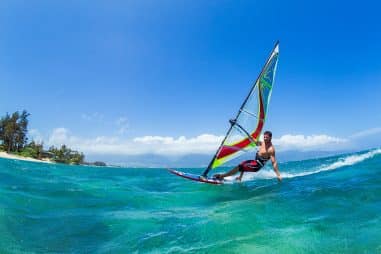To stand on your board, have your body straight, maintaining your shoulder, pelvis, and front ankle in one line. Your board must be pointing across the wind for planing. Steer your board by moving the sail with your weight on your back foot, your hands on the boom. You may do different turns by going upwind or downwind.
How Do You Get Up on a Windsurf Board?
There are two methods you can apply to your windsurfing practice that will save you from scraping your knees while climbing on the board. The first method is called a Beach Start, a fantastic way of launching while in shallow water. The second method is the Water Start, which is most valuable when you’re deep in the water.
Beach Start
- Start by going to shallow water with your board and rig.
- The water depth must be between your knees and your waist.
- Notice the wind direction. You will want to position the mast where it is perpendicular to the wind. Move the sail as necessary to meet this.
- Raise the mast by holding the top mast first. If heavy, you can gain power as you move halfway to where the boom and middle of the mast are.
- Raise the mast out of the water entirely with the mast up and over your head. Ensure the board doesn’t round up.
- Transfer your front hand to the boom and the other hand to the other end of the boom as you control the board with your rig.
- Get your back foot up between your foot straps and the center of the board. Keep your elbows tucked in for more control.
- Find your balance point, and move the board and the sail close to you as you lift yourself, with your front foot on the front of the board.
- Keep your body leaned forward, and start sailing.
Water Start
- While in water, position your board facing into the wind and your sail across the wind. You can do this by grabbing the mast with your front hand.
- Hold the boom with your backhand first, then your front hand. The distance of your hands should be slightly wider than the normal windsurfing position.
- With your front hand, steer your board downwind.
- When in the correct position, place your back foot between the foot straps and the center of the board.
- Prepare yourself to get into the board by extending your front arm up and forward, and use your back foot to keep the board near you.
- Let the wind carry you as you raise the rig and twist it forward.
- Raise yourself by keeping your heard forward and towards the mast foot. Put your front foot on the board when your whole body is over the board.
- Similar to a Beach Start, keep your body leaned forward and start sailing.
Practicing the Beach Start technique first will make it easier for you to transition to Water Start, which will be extremely helpful when you fall and try to get back up while in deep water. It doesn’t take a lot of time, and once you’ve perfected these, you will look graceful as you get up on your board.
How Do You Stand Up on a Windsurfer?
Learning the right way to stand up on your board is crucial to maximizing your practice of riding the wave and the wind with your board. Remember that before starting, studying the wind direction should be determined first. You will then adjust your body accordingly for better performance.
- While in water, get on the board with your back on the wind. The sail is on the opposite side of the wind.
- Stand on your board with the mast in between your feet.
- Grab the uphaul, making sure your back is straight and using the weight of your body. Grab the mast with your hand.
- Move your feet towards the back of the board. Your backfoot must be in between foot straps and the center of the board.
- Take your right hand on the end of the boom. Take the left hand on the other end of the boom. Your arm must be straight to avoid falling into the water.
- To start with the sailing position, maintain a straight front arm.
- Maintain weight on the back foot.
- Keep your back straight to keep your center of gravity on the center of the board. The front ankle, knee, hips, and shoulder should be in one line.
- Start sailing!
A common mistake people do, is grabbing the uphaul without a straight back, causing an injury. An important tip is to keep your arms and back straight. It will avoid falling on your back or in front of you while hauling your sail up.
How Do You Windsurf in the Wind?
Sailing upwind doesn’t mean that windsurfers marvelously sail with the wind in a straight position. Technically, windsurfers follow a 45-degree angle, sailing upwind in a zigzag fashion to take advantage of the closed reach so that the nose is never directly into the wind. Upwind windsurfing is a beginner move that you can do by following the steps below:
- To turn upwind, extend both of your arms down to lean the sail towards the back of the board.
- Keep your back straight as you tip your body weight forward. The front foot must also remain straight.
- Slowly pull the sail in as you turn closer to the wind.
- Go back to the sailing position once your board points towards the location you want to go.
Like sailing upwind, you will also learn the importance of sailing downwind later on in this article. You will need to practice the two together, forming a sort of an infinity symbol. Doing so will help in your steering, lessening the chance of falling as you concentrate on increasing your speed.
What Do Windsurfers Do to Increase Drag?
Increasing your drag requires an understanding of how the wind affects the different points of sail. A small change in how you direct your sail will modify how the wind will affect your speed. When you have practiced enough, you’ll naturally grasp how to navigate your board according to where you’ll get the most out of the wind.
Beam Reach is the point of sail where you can increase your speed, a 90-degree angle perfect for planing. It is popular among windsurfers as it’ll allow you to ride along the water without dealing with the possibility of sailing upwind. With beam reach, you lessen the prospect of drifting too far downwind unintentionally, which is helpful for beginners who struggle to learn how to sail upwind.
How Do You Windsurf Downwind?
Learning to windsurf downwind is as consequential as learning to windsurf upwind. Both are yin and yang, where one cannot simply upwind for long without steering downwind. Here are steps on how to windsurf downwind:
- Keep your front leg straight and your body weight leaning on your back foot.
- Keep your body low as you turn the mast towards the wind.
- Control the power of the sail with your backhand.
- Go back to sailing position once your board is pointing towards the course/location of your choice.
In marginal winds, heading downwind will require more control, hence more power. Heading upwind, on the other hand, doesn’t require power, making it easier to control.
How Do I Start a Windsurfing Plan?
Once you’ve perfected the turns, you will now want to learn how to increase your speed. It’s where the technique called Planing comes into the picture. Before you do this practice, secure a harness with you as you don’t want to get pulled forward off the board by the sail, otherwise called a catapult. Remember, an increase in speed means rougher and stronger winds.
- When planing, use your back foot to bring your body weight down. Leaning with your body weight into the wind will help counter the pull of the sail once robust winds hit.
- As the board picks up speed, keep your body leaning on your back foot with your back straight. Move your back foot further behind into the foot straps while accelerating.
- Maintain your speed by keeping your board flat against the water while you adjust your stance.
Learning to counterbalance will help you effectively control the power in the rig. Keep your front arm extended, keeping the rig away from your body, your body weight supported by your back foot. As you aptly do this, your board will accelerate, allowing you to glide smoothly on the water.
How Much Wind Is Needed to Windsurf a Plane?
You will realize that you won’t need strong winds all the time to move your windsurf board. Technically, 5 miles per hour or 8kph is already plenty of wind for a beginner windsurfer, but no beginner can go beyond 15mph (24kph). Your stance, windsurfing equipment, and level of skills will significantly contribute to your experience planing.
As a beginner, you’ll want to start practicing your footwork and balance first and use a longboard for lighter winds. Start on light winds at 3 miles per hour (5kph), then go higher until you are confident at 15mph (24kph). By that time, your practice is so ingrained in your muscle memory that you will want to upgrade to a shorter board to ride faster winds.
How Do You Steer a Windsurfer?
We have established that sailing upwind and downwind are necessary techniques to steer your board effectively. Let’s talk about different points of sail, which is imperative as you navigate your board towards the direction you want it to go through the wind.
- Closed Hauled: This is where the board is closest to the wind, at a 45-degree angle. You use a zigzag motion to propel forward.
- Close Reach: This is where you sail upwind.
- Broad Reach: This is where you sail downwind. In stronger winds, this can be the fastest point of sail.
- Beam Reach: This is where you sail across the wind and where you have the opportunity to go fast.
- Run: This is where you sail downwind with the wind behind you.
There are different points of sail, each vital when changing your direction and controlling your speed. If your board is pointing directly towards the wind, you will not move as there is no wind to propel you forward. This sailing point is “In Irons,” a direction you would want to avoid when windsurfing.
How Do You Turn on a Windsurf Board?
There are two tactics to follow to change your course while windsurfing. The first one is called Tacking, where the rig passes over the back of the board. The second one is Jibing/Gybing, where the rig passes over the front of the board. Let’s talk steps on how to gybe while on water.
- For better control and balance, place both of your hands on the boom, with enough distance in between. Remember to keep your arm, back, and front foot straight while keeping your body weight leaning on your back foot.
- Keep your body low as you twist the rig forward towards the wind. Keep the clew hand pulled in close to your head.
- Pulling in and down on the clew hand will help lock the rig in place and help counterbalance against the power of the sail.
- Keep the rig at a 90-degree angle as you switch feet, continuing to pull in and down on the clew hand.
- Slide the front hand to the mast, releasing the rear hand and allowing the sail to switch over the front of the board.
- Grab the boom with your hands, draw the rig forward, and stay low.
In lighter winds, this may seem like a simple turn. But once winds are strong and waves are rough, it turns into a rapid, dynamic, and exquisite move. Mastering this move on lighter winds will prepare you for faster turns in stronger winds, called “carved gybes.” It’ll be worth the effort to learn it!
How Do You Tack a Windsurfer?
Tacking is one of the most indispensable maneuvers you’ll need to learn as a windsurfer. It’s the steadiest way of turning your board while keeping you upwind all the time. Your footwork, as well as the way you move your hands, is key to tacking effectively. Here are the steps you can follow for practice:
- Before you tack, notice the wind direction. Look upwind and sail close to the wind.
- When the board is facing directly to the wind, this is your cue to move around the mast.
- From your sailing position, move your front foot around the mast.
- Move your backhand to the boom, around the mast.
- As you go around the mast, get the rig back and your body forward.
- Keep your knees bent, your bum in, and your back straight as your turn and sail off to a new direction.
As you move around the mast, move your front foot and your backhand simultaneously for a fast and stable transition. It is pivotal to step around the mast immediately as soon as the nose points toward the wind. Doing this will help retain your balance and your momentum. As always, look on your shoulder to see where you’re going.
Now that you’ve got the fundamentals, it’s time to get in the water! Keep in mind all the time to look where you’re going, lean on your back foot with your back straight, and maneuver your sail. Happy sailing!

